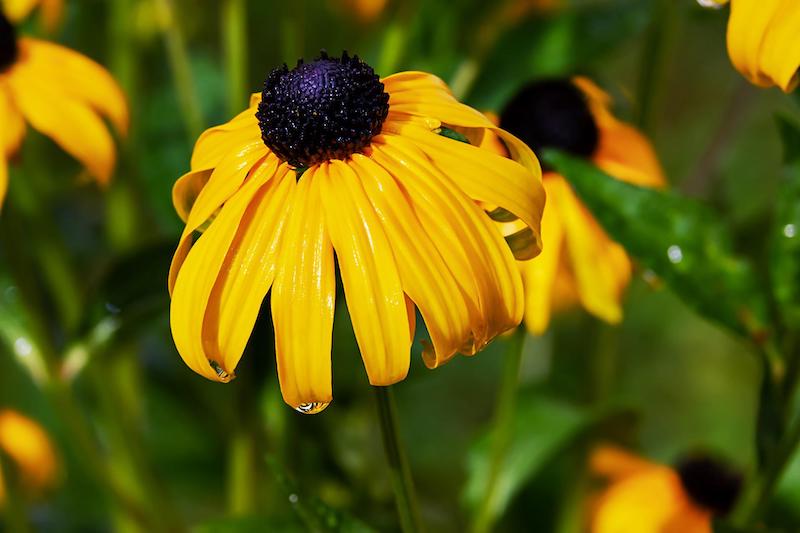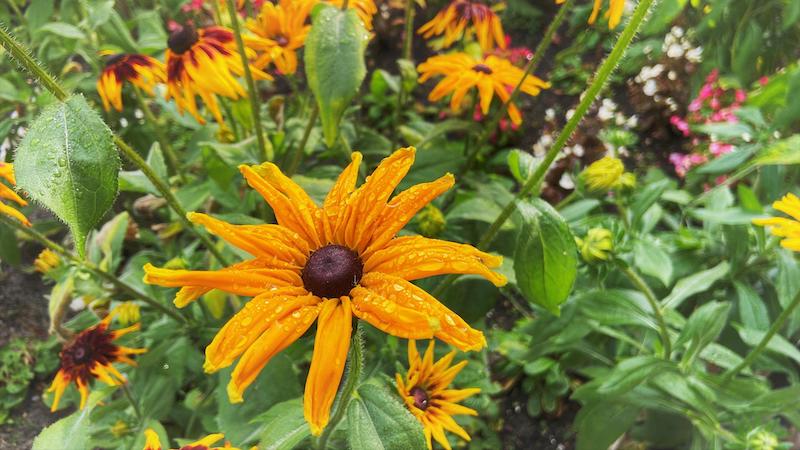Watering perennials well when they are first planted will help them to establish a strong root system as they mature. Even drought tolerant perennials like Black-Eyed Susans need supplemental irrigation in the first few years. The root systems of Black-Eyed Susans should be encouraged to grow deeper in the soil with long watering sessions spaced out, instead of frequent, shallow watering sessions.

How To Tell If Black-Eyed Susans Need To Be Watered
Black-Eyed Susan is a very sturdy plant that doesn’t provide many hints that it needs water until it is completely dry. The soil can be allowed to dry out to 3-4 inches below the surface. Soils that get drier than that will start to stress Black-Eyed Susans. Signs of the stress include stems and foliage that are droopy, and leaves that begin to brown at the tips and edges or fall off altogether. Without enough moisture, flower buds may shrivel and die or just not open.
Overwatering can also be harmful Black-Eyed Susans. Because this plant develops drought resistance, excessive watering or soil that doesn’t drain well can quickly cause roots to rot and die. Symptoms of overwatering are similar to underwatering: yellowing or brown leaves, lifeless-looking plants, and an additional slimy feel to the stems starting at the base of the plant.
How Often To Water Black-Eyed Susans
New Black-Eyed Susan plantings require around 1 inch of water per week to settle in. This amount is best split into 2 or 3 longer sessions during the week. Drip irrigation and soaker hoses are the best way to ensure that all of the water reaches the root system without excessive evaporation or wetting of the plant's leaves.
Mature Black-Eyed Susans will require less water and can go longer between watering. Supplemental watering may only be needed every week to 10 days if no natural precipitation falls. If you live in a climate that stays very humid or has regular rainfall in the summer, supplemental watering may not be needed. Always check the soil moisture levels before watering, either by sight or by feeling below the surface of the soil.
Container-grown Black-Eyed Susans require a bit more attention and consistent watering. Smaller pots will dry out quicker than large planters. The material that the pot is made of also influences how fast it will dry out. Terracotta clay pots are porous and let moisture wick away faster than non-porous plastic.
Black-Eyed Susans will need daily monitoring during the summer heat and long periods of drought. Irrigate the pots until water runs out of the drainage holes on the bottom of the container. This is to ensure that all of the potting soil is saturated evenly. Black-Eyed Susan in containers will still need a period of drying out between waterings. The top 2-3 inches of potting soil should be dry to the touch.

Best Time To Water Black-Eyed Susans
The best time of day to water plants in the ground is as early as possible in the morning. The soil will be cooler and may even already be slightly damp from heavy dew, allowing all of the soil to be saturated evenly. Plants that get wet from overhead watering will have a chance to dry their leaves during the day. Mildews occur often as a result of wet foliage and cooler temperatures, like at night.
Container-grown plants will also benefit from morning watering, although as long as the leaves are kept dry, watering can happen any time that it is needed. Do not wait if the plant is very stressed from lack of moisture.
Watering through the winter is not needed for herbaceous perennials. The top growth will have died back before dormancy. The root systems can survive in drier conditions throughout the winter months while not actively growing.
How to Water Black-Eyed Susans
Step 1 - Check the soil to see if it is damp under the surface
Sandy soils dry out the fastest, while soils with high clay content will retain moisture far longer and at lower levels.
Step 2 - Water with drip irrigation or soaker hose at a slow rate
Drip irrigation right at root level conserves the most water and keeps foliage dry.
Step 3 - Water until at least 5-6 inches of soil are wet under the surface
Deeper watering encourages the roots to grow deeper and become more tolerant of drought and heat.
Step 4 - Hand water with a can or spray head until a small amount of standing water pools on the surface of the soil
The pooling ensures that the soil is fully saturated.
Step 5 - Let the water soak in fully
Continue to add more water until the lower levels of the soil are sufficiently wet.
Step 6 - Let Black-Eyed Susan plants dry out a bit in between waterings
Black-Eyed Susan Watering Tips
- Black-Eyed Susan is a native plant that prefers drier soil and develops drought tolerance
- Overwatering and underwatering symptoms often are the same
- Fewer, longer watering sessions force the roots to grow deeper in the soil
- Good watering practices from the time of planting will help Black-Eyed Susan establish well
 |
Author Robbin Small - Published 7-31-2022 |
